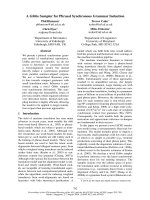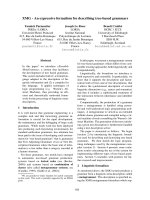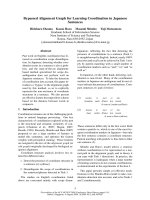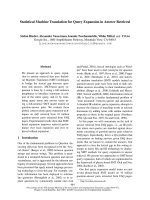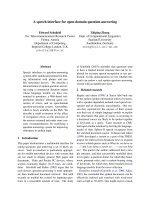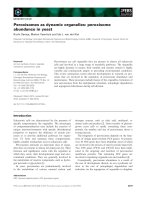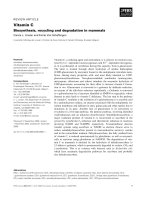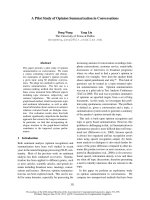Báo cáo khoa hoc:" Revised COGNOSAG guidelines for gene nomenclature in ruminants " doc
Bạn đang xem bản rút gọn của tài liệu. Xem và tải ngay bản đầy đủ của tài liệu tại đây (310.11 KB, 6 trang )
Letter
to
the
editor
Revised
COGNOSAG
guidelines
for
gene
nomenclature
in
ruminants
1998
1
Thomas
E.
Broad
a
Charles
H.S.
Dolling
Jean-Jacques
Lauvergne
c
Paul Millar
a
AgResearch,
P.B.
50034,
Mosgiel,
New
Zealand
b
Box
74,
McLaren
Vale,
South
Australia
!
Laboratoire
de
Génétique
factorielle,
bât.
211,
CRJ/Inra,
78352
Jouy-en-Josas
cedex,
France
d
12A
Riselaw
Crescent,
Edinburgh,
Scotland
EH10
6HL,
UK
(Received
14
January
1999)
Abstract -
The
1993
guidelines
proposed
by
COGNOSAG
were
designed
to
accom-
modate
the
naming
of
loci,
including
mapped
and
cloned
loci
in
all
ruminants,
and
to
facilitate
the
development
of
a
genome
nomenclature
consistent
as
far
as
possible
between
ruminant
species.
The
guidelines
have
been
revised,
and
COGNOSAG
recom-
mends
that
they
be
adopted
not
only
for
the
ruminants
sheep,
cattle
and
goats
but
also
for
other
farmed
animals,
such
as
pigs,
horses,
deer
and
camelids.
©
Inra/Elsevier,
Paris
ruminants
/
genes
/
nomenclature
Résumé -
Règles
de
nomenclature
du
COGOVICA
pour
les
gènes
des
ruminants,
révisées
pour
1998.
Les
règles
de
nomenclature
proposées
en
1993
concernaient
tous
les
gènes
et
loci
cartographiés
et
clonés
des
ruminants.
Le
but
était
de
faciliter
l’élaboration
d’une
nomenclature
rationnelle
du
génome
de
ces
espèces.
Dans
le
présent
article
ces
règles
ont
été
révisées
et
le
COGOVICA
recommande
qu’elles
soient
étendues
non
seulement
aux
ruminants
comme
le
mouton,
la
chèvre
et
le
boeuf
mais
aussi
à
d’autres
animaux
de
ferme
comme
le
porc,
le
cheval,
le
cerf
et
les
camélidés.
©
Inra/Elsevier,
Paris
ruminants
/
gènes
/
nomenclature
*
Correspondence
and
reprints
E-mail:
1
The
revised
guidelines
were
endorsed
by
the
13th
COGNOSAG
Workshop
at
Lednice,
Czech
Republic
in
July
1998.
1.
INTRODUCTION
The
guidelines
from
the
1998
Workshop,
held
at
the
Mendel
University
of
Agriculture
and
Forestry
Brno,
Lednice,
Czech
Republic,
are
based
on
ear-
lier
proposals
from
COGNOSAG
Workshops
at
Gontard/Manosque,
France,
July
1986
[5]
and
July
1987
[1],
at
Eugene,
Oregon,
June
1989
[2],
at
Gontard/Manosque,
July
1991
[3],
and
at
the
Turretfield
Research
Centre,
Rosedale,
South
Australia,
1993
(4!.
The
core
of
these
revised
guidelines
consists
of
the
1991
proposals
[3].
Their
re-wording
has
been
undertaken
to
reduce
their
length,
and
to
increase
their
clarity.
The
earlier
recommendations
to
limit
the
length
of
symbols
of
loci
and
alleles
to
a
maximum
of
five
and
four
characters,
respectively,
have
been
relaxed.
The
designation
of
top
dominant
and
co-dominant
alleles
by
a
capital
initial
letter
has
been
undertaken
to
assist
in
the
recognition
of
alleles
with
visible
effects.
Thus,
the
changes
made
are
intended
to
render
the
guidelines
more
permissive
and
user-friendly,
while
retaining
consistency
with
the
human
and
mouse
systems
of
nomenclature.
Our
recommendations
include
the
use
of
species
prefixes,
for
example,
OOV or
OAR
for
sheep,
BTA
or
BBO
for
cattle,
and
the
adoption
of
the
nomenclature
for
keratins
and
keratin-
associated
proteins
proposed
by
Powell
and
Rogers
(6!.
An
additional
proposal
for
provisionally
assigning
symbols
and
listing
newly
reported
DNA
segments
and
proteins
that
have
no
known
homologues,
official
names
or
symbols
is
also
outlined.
COGNOSAG
will
respect
as
far
as
possible
the
names
of
loci
and
alleles
proposed
by
authors
and
will
propose
new
names
only
in
the
light
of
new
knowledge
or
to
maintain
consistency
with
the
existing
nomenclature.
The
use
of
names
and
symbols
in
italics
for
loci
and
their
alleles
is
preferred.
However,
if
it
is
not
possible
to
comply
with
this,
then
those
names
and
symbols
will
be
underlined.
Authors
are
asked
to
be
consistent
in
the
underlining
or
use
of
italics
for
the
names
and
symbols
within
a
document
and/or
file.
Locus
and
allele
symbols
need
not
be
in
italics
or
underlined
in
databases,
but
should
be
in
italics
in
hardcopy
from
these databases.
2.
LOCUS
2.1.
Locus
name
2.1.1.
Choice
of
name
The
name
in
English
should
be
as
brief
as
possible
but
not
consist
of
a
single
letter,
and
should
convey
as
accurately
as
possible
the
character
affected
or
the
function
by
which
the
locus
is
recognised.
The
name
may
indicate
a
morphological
character
(Ear
Length)
or
disease
character
(Photosensivity),
a
body
system
or
body
function
(Fecondity
Java),
or
a
biochemical
property
(Albumin)
or
nucleotide
segment
(DNA
Segment:
probe
MAF4).
As
far
as
possible
the
locus
name
should
reflect
interspecies
homology.
All
Greek
symbols
should
be
written
in
full
in
Latin
letters
and
placed
after
the
name,
e.g.
(3
Haemoglobin
becomes
Haemoglobin
Beta.
If
a
newly
described
locus
has
an
effect
similar
to
one
that
has
already
been
named,
then
it
may
be
named
according
to
the
breed,
geographic
location
or
population
of
origin.
2.1.2.
Printing
the
name
The
locus
name
should
be
written
in
Latin
letters
or
in
a
combination
of
Latin
letters
and
Arabic
numerals.
Wherever
possible,
the
locus
name
should
be
printed
in
italics;
otherwise
it
should
be
underlined.
The
initial
letter
of
the
locus
name
should
be
a
capital
Latin
letter.
Both
nouns
and
adjectives
in
locus
names
should
begin
with
capital
Latin
letters,
e.g.
Ear
Length,
Haemoglobin
Beta:
Ear
Length,
Haemoglobin
Beta:
Ear
Length,
Haemoglobin
Beta.
2.2.
Locus
symbol
2.2.1.
Choice
of
symbol
For
newly
reported
loci,
unmapped
DNA
segments
and
proteins
which
have
no
known
homologues
or
official
names
or
symbols,
special
care
should
be
exercised
in
selecting
an
appropriate
symbol
to
avoid
duplication
and
confusion
with
existing
nomenclature
(see
section
2).
Every
effort
should
be
made
to
ensure
that
the
symbols
selected
conform
to
those
in
current
use
for
homologous
loci.
The
locus
symbol
should
consist
of
as
few
Latin
letters
as
possible,
or
a
combination
of
Latin
letters
and
Arabic
numerals.
The
initial
character
should
always
be
a
capital
Latin
letter
which,
if
possible,
should
be
the
initial
letter
of
the
name
of
the
locus.
For
loci
other
than
those
for
coat
colour
and
visible
traits,
upper-case
Latin
letters
only,
or
upper-case
letters
combined
with
Arabic
numerals,
should
be
used.
If
the
locus
name
is
of
two
or
more
words
and
the
initial
letters
are
used
in
the
locus
symbol,
then
the
letters
should
be
in
Latin
capitals.
All
characters
in
a
locus
symbol
should
be
written
on
the
same
line;
no
superscripts
or
subscripts,
and
no
Roman
numerals
or
Greek
letters
should
be
used.
Where
appropriate,
the
symbol
should
indicate
the
biochemical
property
or
designate
a
particular
nucleotide
segment.
The
rules
of
mammalian
inter-specific
homology
already
used
in
the
choice
of
the
name
of
the
locus
should
be
applied
to
the
choice
of
the
symbol.
The
designation
of
prefixes
denoting
mammalian
species
of
origin,
when
be-
ing
used
to
distinguish
between
the
species
homologues
of
a
locus,
should
follow
either
that
recommended
by
The
Human
Genome
Nomenclature
Committee,
e.g.
OOV or
OAR
for
sheep,
BTA
or
BBO
for
cattle,
CHI
for
goat,
SSC
for
pig
and
ECA
for
horse.
COGNOSAG
recommends
that
each author
be
con-
sistent
in
the
use
of
whichever
symbol
has
been
chosen.
For
the
keratins
and
keratin-associated
proteins,
COGNOSAG
recommends
that
authors
adopt
the
symbols
and
names
proposed
by
Powell
and
Rogers
!6!.
2.2.2.
Printing
the
symbol
Wherever
possible
the
locus
symbol
should
be
in
italics;
otherwise
it
should
be
underlined,
e.g.
the
symbol
of
the
Agouti
locus:
A
or
A.
3. ALLELES
3.1.
Allele
name
3.1.1.
Choice
of
name
The
name
should
be
as
brief
as
possible,
but
should
convey
the
variation
associated
with
the
allele.
If
not
given
names,
alleles
should
be
given
symbols
as
described
in
section
3.2
below.
If
a
newly
described
allele
is
similar
to
one
that
is
already
named,
it
should
be
named
according
to
the
breed,
geographic
location
or
population
of
origin.
The
names
of
new
alleles
at
a
recognised
locus
should
conform
to
the
nomenclature
established
for
that
locus.
Should
a
new
allele
be
identified
later
as
being
the
same
as
an
allele
already
named,
the
name
invoking
breed,
geographic
location
or
population
of
origin
should
be
abandoned.
3.1.2.
Printing
the
name
Wherever
possible,
the
allele
name
should
be
in
italics;
otherwise
it
should
be
underlined.
A
lower-case
initial
letter
of
the
allele
name
is
preferred.
This
does
not
apply
when
a
symbol
is
used
instead
of
an
allele
name.
For
example,
the
allele
for
the
polled
condition
at
the
Horns
locus
in
sheep:
polled
or
polled;
an
allele
at
the
Haemoglobin
Beta
locus:
B
or
B.
-
3.2.
Allele
symbol
3.2.1.
Choice
of
symbol
The
allele
symbol
should
be
as
brief
as
possible,
consisting
of
Latin
letters
and/or
Arabic
numerals.
As
far
as
possible,
the
allele
symbol
should
be
an
abbreviation
of
the
allele
name,
and
should
start
with
the
same
letter.
In
the
loci
detected
by
biochemical,
serological
or
nucleotide
methods,
the
allele
name
and
symbol
may
be
identical.
Greek
letters
and
Roman
numerals
should
not
be
used.
The
symbol
’+’
can
be
used
alone
for
identification
of
the
standard
allele
(’wild
type’)
for
alleles
having
visible
effects.
Neither
’+’
nor ‘-’
symbols
should
be
used
in
alleles
detected
by
biochemical,
serological
or
nucleotide
sequencing
methods.
Null
alleles
should
be
designated
by
the
number
zero.
The
initial
letter
of
the
symbol
of
the
top
dominant
allele
should
be
a
capital
letter.
When
there
are
co-dominant
alleles
only,
they
should
each
have
a
capital
initial letter.
The
initial
letter
of
all
other
alleles
should
be
in
lower
case.
3.2.2.
Printing
the
symbol
The
allele
symbol
should
always
be
written
with
the
locus
symbol.
It
may
be
written
as
a
superscript
following
the
locus
symbol,
or
following
an
asterisk
on
the
same
line
as
the
locus
symbol.
The
allele
symbol
should
be
printed
immediately
adjacent
to
the
locus
symbol,
i.e.
with
no
gap
between
them.
Wherever
possible,
the
allele
symbol
should
be
in
italics;
otherwise
it
should
be
underlined.
For
example,
the
recessive
allele
hornless
at
the
Horns
locus
in
sheep
will
be
printed
in
italics:
Ho hi
or
Ho
*hl
or
underlined
Hohl
or
Ho
*hl
The
dominant
allele
polled
will
have
the
symbol
in
italics,
Ho
P
or
Ho*P
,
or
underlined,
Ho
p
or
Ho*P
5.
GENOTYPE
TERMINOLOGY
The
genotype
of
an
individual
should
be
shown
by
printing
the
relevant
locus
and
allele
symbols
for
the
two
homologous
chromosomes
concerned,
separated
by
a
slash,
e.g.
Ho
P
/Ho
P
or
HoP
/H
oP.
Unlinked
loci
should
be
separated
by
semicolons.
Linked
or
syntenic
loci
should
be
separated
by
a
space
and
listed
in
alphabetical
order
when
gene
order
and/or
phase
are
not
known.
In
writing
genotypes
for
X-linked
loci,
the
hemizygous
case
(as
in
the
male)
should
be
designated
by
/Y
following
the
locus
and
allele
symbols,
e.g.
FecX *I!Yfor
the
inverdale
allele
of
the
Fecundity
X
locus
on
the
X
chromosome
in
sheep.
In
writing
genotypes
Y-linked
loci
should
be
designated
by
/X
following
the
locus
and
allele
symbols.
6.
PHENOTYPE
TERMINOLOGY
The
phenotype
symbol
should
be
in
the
same
characters
as
the
locus
and
allele
symbols.
The
difference
is
that
the
characters
should
not
be
in
italics,
should
not
be
underlined
and
should
be
written
with
a
space
between
locus
characters
and
allele
characters
instead
of
with
an
asterisk.
Square
brackets [
]
may
also
be
used.
For
example,
the
dominant
genotype
Ho
P
/Ho
+
is
equivalent
to
the
phenotype
Ho
p
or
[Ho
P]
ACKNOWLEDGEMENTS
The
authors
have
presented
these
guidelines
on
behalf
of
all
of
those
members
of
COGNOSAG
who
attended
the
13th
workshop
since
the
organisation
was
founded
in
1984.
They
gratefully
acknowledge
the
complementary
efforts
of
members
around
the
world
and
the
support
of
their
host
institutions
which
has
made
these
efforts
possible.
REFERENCES
[1]
COGNOSAG
(Alexieva
S.A.,
Denis
B.,
Dolling
C.H.S., Lauvergne
J.J., Lundie
R.S.,
Millar
P.,
Rae
A.L.,
Renieri
C.,
Sponenberg
D.P.,
Tucker
E.M.),
Proposed
guidelines
for
gene
nomenclature
in
sheep
and
goats
1987,
in:
Lauvergne
J.J.
(Ed.),
Standardized
Genetic
Nomenclature
for
Sheep
and
Goats
1987.
Loci
for
Visible
Traits
other
than
Colour
and
Blood
and
Milk
Polymorphisms,
Proc.
COGNOSAG
Workshop
1987,
Gontard,
Manosque,
Bureau
des
ressources
génétiques,
Paris,
1989,
pp.
17-21.
[2]
COGNOSAG
(Alexieva
S.A.,
Aliev
G.A.,
Bourzat
D.,
Denis
B.,
Dolling
C.H.S.,
Lauvergne
J.J.,
Lundie
R.S.,
Malher
X.,
Millar
P.,
Rachkovsky
M.L.,
Rae
A.L.,
Renieri
C.,
Sponenberg
D.P.,
Tucker
E.M.),
Gene
nomenclature
in
sheep
and
goats
1989,
in:
Lauvergne
J.J.
(Ed.),
Loci
for
Coat
Colour
of
Sheep
and
Goats
1989,
COGNOSAG
Clamart,
1990,
pp.
3-7.
[3]
COGNOSAG
(Andresen
E.,
Broad
T.E.,
Di
Stasio
L.,
Dolling
C.H.S.,
Hill
D.,
Huston
K.,
Larsen
B.,
Lauvergne
J.J.,
Levéziel
H.,
Malher
X.,
Millar
P.,
Rae
A.L.,
Renieri
C.,
Tucker
E.M.),
Guidelines
for
gene
nomenclature
in
ruminants,
1991,
Genet.
Sel.
Evol.
23
(1991)
461-466.
[4]
COGNOSAG
(Andresen
E.,
Broad
T.E.,
Brown
S.,
Cooper
D.W.,
Di
Stasio
L.,
Dolling
C.H.S.,
Fleet
M.,
Hill
D.F.,
Lauvergne
J.J.,
Lundie
R.S,
Maddox
J.,
Nicholas
F.W.,
Rae
A.L.,
Renieri
C.,
Sponenberg
D.P.,
Tucker
E.M.),
Revised
guidelines
for
gene
nomenclature
in
ruminants
1993,
Genet.
Sel.
Evol.
27
(1995)
89-93.
[5]
COGNOSAG
Workshop
1986,
Proposed
rules
for
genic
nomenclature
in
sheep
and
goats,
in:
Lauvergne
J.J.
(Ed.),
Standardized
Genetic
Nomenclature
for
Sheep
and
Goats,
1986,
Proc.
COGNOSAG
Workshop,
Gontard/Manosque,
July
1986,
Bureau
des
ressources
génétiques
and
Lavoisier,
Paris,
1988,
pp.
89-92.
[6]
Powell
B.C.,
Rogers
G.E.,
Differentiation
in
hard
keratin
tissues,
hair
and
related
structures,
in:
Leigh
I.,
Watt
F.,
Lane
E.B.
(Eds),
Keratinocyte
Handbook,
Cambridge
University
Press,
Cambridge,
UK,
1993.
